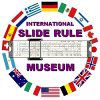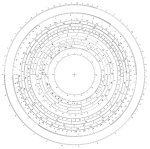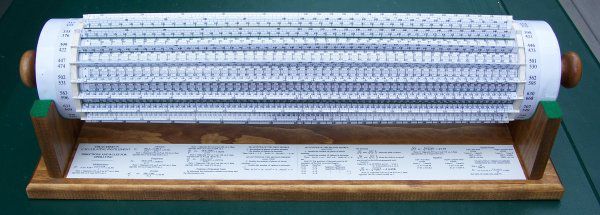
|
Slide Rule Scales
Scales for building your own slide rule
|
KEEP ISRM FREE!
Donations are
tax deductable
|
-
Reference Scales - Cut and Paste to Create a Slide Rule - Andrew Nikitin
- Build a Basic Slide Rule - Scales: A,B,C,D - Brian Ronald (UK)
- Make your own Slide Rule - Scales: D, L, S [ B, CI, C ] T, K, A - Published in Scientific American
- Build a Mannheim Slide Rule - Scales: K, A,B,L,C,D - Kinsman (USA)
- Build a Circular Slide Rule using a CD case - Ying Hum (Canada)
- Build a Circular Slide Rule for Amateur Ham Radio - Patrick Egloff (Corsica)
- Build a Log-Log Slide Rule - Version A - John Savard (Canada)
- Build a Log-Log Slide Rule - Version B - John Savard (Canada)
- Build a Circular SR - Multiple Overlays - John Savard (Canada)
- Build a Circular Slide Rule (Simple)- Charles Kankelborg (USA)
- Build Sexton Omnimetre Circular Slide Rule - Wayne Harrison
- Build Thacher Cylindrical Slide Rule - Wayne Harrison
- Thacher Build Example 1 - David White
- Thacher Build Example 2 - Bob Wolfson
- Build an Otis King Cylindrical Slide Rule - Peter Monta
- Scales of the SR or Doing the Math - Jason Waskiewicz
- Build Your Own Nuclear Bomb Effects Computer by John Walker
Top
Slide Rule Reference Scales
These are very handy when trying to describe an older slide rule
without scale labels or when the instructions are written in Cyrillic.
These superb graphics are courtesy of Andrew Nikitin. The graphics can be
used to construct a custom slide rule scale set by copying and pasting
into a picture editor and printing out onto paper or transparancies.
Due to popular request, the following 75 reference scale images are combined into
one file that you can download:
SR_scales.zip.
Just right-click and save target to your computer, then you can un-zip them.
| cm |  |
| inch |  |
| 3R1 |  |
| 3R2 |  |
| 3R3 |  |
| A |  |
| Adk |  |
| AI |  |
| B |  |
| Bdk |  |
| BI |  |
| C |  |
| Cdk |  |
| Cel |  |
| CF |  |
| CF10 |  |
| CF1M |  |
| CF36 |  |
| CFM |  |
| CI |  |
| CIdk |  |
| CIF |  |
| CIF10 |  |
| CIF1M |  |
| CIF36 |  |
| D |  |
| Ddk |  |
| DF |  |
| DF10 |  |
| DF1M |  |
| DF36 |  |
| DFM |  |
| DI |  |
| DIF |  |
| DIF10 |  |
| DIF36 |  |
| DIFM |  |
| F |  |
| Far |  |
| FI |  |
| ISTd |  |
| K |  |
| Kdk |  |
| KI |  |
| L |  |
| Ldk |  |
| LL0 |  |
| LL00 |  |
| LL01 |  |
| LL02 |  |
| LL03 |  |
| LL1 |  |
| LL2 |  |
| LL3 |  |
| Ln |  |
| P |  |
| R1 |  |
| R2 |  |
| S |  |
| S' |  |
| sin |  |
| sin' |  |
| ST |  |
| ST' |  |
| T |  |
| T' |  |
| T2 |  |
| T2' |  |
| U |  |
| U-1 |  |
| U12 |  |
| V |  |
| V-1 |  |
| V12 |  |
| V2 |  |
| X |  |
| Y |  |
Top
Scales to make a Basic Slide Rule
A [ B, C ] D - by Brian Ronald

Top
Make your own Slide Rule
D, L, S [ B, CI, C ] T, K, A - Published in Scientific American
Read the full article:

Scientific American Article May 2006 When Slide Rules Ruled by Cliff Stoll (16.8MB PDF)
|

|
Download and print this PDF file. You can build a working slide rule from paper and cellophane tape. Photocopying these plans onto thicker paper yields a reasonably robust calculating instrument.Scientific American, May, 2006
|
Top
Scales to make a Mannheim Slide Rule
K, A [ B, L,C ] D - by Andrew Kinsman

|

Andrew has collected slide rules since 1972. He writes: "I worked at Eastman Kodak for 30 years as a software engineer specializing in real-time microprocessor projects, retiring in early 2006. I helped design and program automated warehouses, blood analyzers, robotics, rotary microfilmers, copiers, computer controlled lens grinding machines, printers, cameras, cell phones and several interesting military projects.
In retirement I help the nearby FIRST robotics team and my brother who teaches high speed photography at a nearby college with all his computer projects. I almost always have some Arduino project in the works while getting ready for the next makerfaire." For questions, Andrew's contact info is: sneelocke[]aol[]com
|
Top
Scales to make a Circular Slide Rule using a CD Case
by Ying Hum (VA3YH) Canada
There are 2 circular slide rule options shown. Each just needs to be cutout and placed onto a CD case.
If you download the instructions, two of the basic slide rules are also attached. One is a replica of a Concise 270. The PDF files are to scale so just be careful in cutting the center hole.



Ying won a reward for this innovative application. His son is shown cutting out one of the disks.


Top
Scales for an Amatuer(Ham) Radio Circular Slide Rule
by Patrick Egloff (VA3YH) Corsica
This is circular slide rule calculate a gain, loss or SWR when measuring powers or working on antennas.
A very handy device if you are an Ham. (the ISRM curator happens to be KI0CC out of Colorado).
The principle is simple, the powers are on 4 decade logarithmic scales, for a 40 dB range.
The gain and return loss use the same 40 graduations linear scale and the SWR is a special
scale responding to the SWR vs power formula.
To use the chart, you only have to align the 2 powers on 2 concentric disks and you read
the result in a small window. There is a short explanation on the disk itself.
The scale permits direct reading up to 40 dB with powers from 0.1 W to 1 kW, and all other
scales with a small mental reflection. For example : for 0.1 mW to 1 W and 100 W to 1000 kW.
For more details on the construction and use, go to Patrick's
TK5EP Home Page.


Top
Scales to make a Log-Log Slide Rule
Version A - by John J.G. Savard
Front Scales: ST, S, T1, T2, A, K1 [ K2, R1, R2, LL0, LL1, LL2, LL3, C ] D, DI, SH1, SH2, TH
Back Scale (Flip Slide Over): [ LL, LL00, LL01, LL02, LL03, P, L, CI ]
Visit John Savard's Web Page,
a mathematically oreinted web site that focuses on cryptology, ciphers and map
projections along with many topics in mathematics, science, computers and Chess.

Top
Scales to make a Log-Log Slide Rule
Version B - by John J.G. Savard
50 inch Scales design
Front Scales: ST, S, T1, T2, K, A [ B, P, M1, M2, M3, M4, M5, C ] D, R1, R2, Q1, Q2, Q3
Back Scale (Flip Slide Over): [ BI, LL0, LL1, LL2, LL3, L, CF, CI ]

Top
Scales to make a Circular Slide Rule
Multiple Overlays by John J.G. Savard
Here's are 3 circular rules from John that uses the same overlay (which makes both the
rotating scales and the cursor), and 3 different white bodies. These variations offer a wide
range of circular designs, in a large (8 inch diameter). Make the base images on white material,
or adhesive white material, and then laminate them to suitable card stock or other material.
Make the clear layer on clear material, and cut the cursors out in any shape you prefer.
All three items are then fastened in the center and secured with either a screw and nut or
other fastener, and the rule is ready to use. (This and the following descriptions were written by Walter Shawlee of Sphere Research)
Note: The scale identifiers (A, B, C, S, T, etc.) are added to every scale at the half interval marks
(an unusual visual technique, but very effective). In this way, the scales are identifed no matter where the rule is positioned.

|
The first of three templates to build a circular slide rule background. This one is for a general-purpose rule, except that
hyperbolic functions are present, and log-log scales omitted. This is peculiar, but it is intended that this rule will be used in
conjunction with the one with two four-decade log-log scales, normal and reciprocal, as part of a set.
|

|
This is the second of three possible backgrounds for the circular slide rule. This one features a logarithmic scale for
multiplication that makes five turns around the rule. Unlike earlier versions of my circular slide rule, I put it far enough
towards the outside that I could graduate it for a 20 inch rule instead of as for a 10 inch rule. Given the binary
capability of the overlay design, it can indeed be used for accurate multiplication.
|

|
This is the third of three backgrounds for the circular slide rule. This one contains conventional log-log and inverse log-log scales.
The log-log scales, but not the inverse log-log scales, are graduated for a 20" rule, except the last little bit.
|

|
This file is the one that needs to be printed on clear plastic as the overlay for the family of three circular slide rules.
Note the cursor line on the main disc, as well as the cursor templates (for which no border is given). This allows the rule
to be used both in the simple fashion of a conventional slide rule for combinations involving one of the scales on the overlay,
and as a "binary" type slide rule for any arbitrary pair of scales on the base as well.
|
Top
Scales to make a Circular Slide Rule
Log-Log Version A by Charles Kankelborg
Top
Scales to make a Sexton's Omnimetre Circular Slide Rule c1898
Author: Wayne Harrison, nwharrison[]sympatico[]ca Copyright January 2020
Website: Wayne Harrison's Slide Rules


Secton Omnimetre Circular Slide Rule build Instructions
Top
Scales to make a Thacher Cylindrical Slide Rule
Author: Wayne Harrison, nwharrison[]sympatico[]ca Copyright January 2002

Thacher Cylindrical SR c1910

Thacher Scale Example
 Thacher Bars, full-sized, prints on single sheet 18.5" x 20"
Thacher Bars, full-sized, prints on single sheet 18.5" x 20"
 Thacher Drum, full-sized, prints on single sheet 13.5" x 20"
Thacher Drum, full-sized, prints on single sheet 13.5" x 20"
 Thacher Bars, legal sheet size, multiple pages
Thacher Bars, legal sheet size, multiple pages
 Thacher Drum, legal sheet size, multiple pages.
Thacher Drum, legal sheet size, multiple pages.
 Kinko's print ready Adobe format .KDF Thacher Bars, full sized, prints on single sheet 18.5" x 20"
Kinko's print ready Adobe format .KDF Thacher Bars, full sized, prints on single sheet 18.5" x 20"
 Kinko's print ready Adobe format .KDF Thacher Drum, full sized, prints on single sheet 13.5" x 20"
Kinko's print ready Adobe format .KDF Thacher Drum, full sized, prints on single sheet 13.5" x 20"
Top
Thacher Build Example 1


|
David White of Essex, Massachusetts, built this beautiful rendition of a Thacher using the above Thacher scales.
Click on the pictures and pdf to see how he did it. Contact: whitey5656 [at] hotmail.com
|








Top
Thacher Build Example 2


|
Bob Wolfson of Marietta, Georgia, built another beautiful rendition of a
Thacher using the above Thacher scales.
Contact: bobwolfson [at] gmail.com
|


Top
Build an Otis King Cylindrical Slide Rule

 1.3MB 1.3MB
POSTSCIPT (.PS) file 1.4MB
|

Peter Monta made this scale sheet using a 'C' file to create a postscript file of Otis King Model L scales. to fit rigid tubing.
Directions:
Cut out the pieces using the trim lines. A paper trimmer is recommended,
but scissors may be used if the trim lines are joined by pencil and
straightedge, then carefully cut inside the line so no pencil shows in
the final article.
Wrap the lower scale and upper scale into cylinders and secure along the
seam with transparent tape (the matte-surface 3M Magic tape works well).
The tape should go on the outside of the upper scale and on the inside of
the lower scale, so that when they are telescoped there will be a smooth,
paper-to-paper sliding action. Make sure the small tick marks keep their
uniform spacing across the seam---gaps or overlaps will degrade the
rule’s accuracy.
Telescope the upper scale into the lower scale. The lower scale is
horizontally stretched by 1.2 percent to allow this to happen (this value
is appropriate to the thickness of ordinary laser printer paper).
Wrap the cursor around the assembly. Aim for a slightly looser fit than
the two main tubes, then tape. There is no harm in an overlapped joint
for this part, and it is much easier to make and adjust.
Set or read the scales from directly above, not from an angle. The
cursor mark rides slightly above the upper scale, so parallax must be
eliminated for best accuracy.
Directions for use, and much other lore besides, can be found at
http://www.svpal.org/~dickel/OK/OtisKing.html
|
Top
The Scales of the Slide Rule - Doing the Math
Note: The following was written in 1999 by Jason Waskiewicz. It is a very good
example on how the divisions of the slide rule scales are calculated. You can use these to create any length of slide rule - Mike
In the first column is the scale name. In the second column
is the formula used for that scale. Any simplification is left as an
exercise for the reader. The convention used is that R denote
the length of the rule and # denotes the number on the scale
whose position is being calculated. The final column contains notes
about the particular scale.
Derivation of the scales was not always easy, and I have not shown here
how it was done. Essentially, I went in knowing that the whole thing
was based on logarithms, and then played around until I came up with
something that worked. Generally I started out quite close -- it
became mainly a matter of playing with constants. Jason.
| Scale
| Formula
| Comments
|
| A/B
| (R/2)*log(#)
| Used to calculate squares
and square roots with the D scale, used to
calculate the sine of an angle with the S
scale on a Mannheim slide rule
|
| C/D
| R*log(#)
| Used in multiplication and division,
and also used with many other scales in
various operations
|
| CF/DF
| (log# - logPI)*R
if # less than R then add R
| The folded scales used as a shortcut in
multiplication and division
|
| CI
| abs[R*log(10/#)-R]
| The inverse of the C scale, often
used as a shortcut in division
|
| CIF
|
abs[R*(log(1/#) - log(1/PI))]
if #<(10/PI)
|
abs[R*(log(1/#) - log(1/PI)) - 25]
if #>(10/PI)
|
| The inverse of the CF scale
|
| K
| (R/3)*log(#)
| Used with the D scale to find the
cube or cube root of a number
|
| L
| #*R
| Used with the D scale to calculate the
logarithm log10(#) of a number
|
| LL0
| log(ln(#))*R + 3*R
| Contains all numbers greater than or equal
to 1.001 and less than or equal to 1.01; these
scales (LL0-LL3) are used for logarithms, roots,
and powers
|
| LL1
| log(ln(#))*R + 2*R
| Contains all numbers greater than or equal
to 1.01 and less than or equal to 1.105
|
| LL2
| log(ln(#))*R + R
| Contains all numbers greater than or equal
to 1.105 and less than or equal to e
|
| LL3
| log(ln(#))*R
| This contains all numbers greater than or
equal to e
|
| LL/0
| log(ln(1/#))*R
+ 3*R
| This contains all numbers greater than or
equal to e-0.01 and less than
or equal to e-0.001
|
| LL/1
| log(ln(1/#))*R
+ 2*R
| This contains all numbers greater than or
equal to e-0.1 and less than
or equal to e-0.01
|
| LL/2
| log(ln(1/#))*R + R
| This contains all numbers greater than or
equal to e-1.0 and less than
or equal to e-0.1
|
| LL/3
| log(ln(1/#))*R
| This contains all numbers greater than or
equal to e-10.0 and less than
or equal to e-1.0
|
| R1
| log(#)*2*R
| Used with the D scale to find
squares and square roots; those numbers greater
than about 3.13 are on the R2 scale
|
| R2
| [log(#)*2*R] - 25
| Used with the D scale to find
squares and square roots; those numbers greater
than about 3.13 are on the R2 scale
|
| Smannheim
| (R/2)*[2 +
log(sin(#))]
| Used with the A scale to calculate the sine
of a number, or the tangent of a number less than
5.7 degrees
|
| S,T
| [log(100*sin(#))]*R
| Used with the C scale to calculate the sine
or the tangent of a number less than 5.7 degrees
|
| S
| [log(10*sin(#))]*R
| Used with the C scale to calculate the sine
of a number greater than 5.7 degrees
|
| T
| R*log[10*tan(#)
| Used with the D scale to calculate the
tangent of angles greater than 5.7 degrees
|
copyright © 1999 Jason Waskiewicz - Contact: waskiewi [at] sendit.nodak.edu
|







































































































 Kinko's print ready Adobe format .KDF Thacher Bars, full sized, prints on single sheet 18.5" x 20"
Kinko's print ready Adobe format .KDF Thacher Bars, full sized, prints on single sheet 18.5" x 20"












